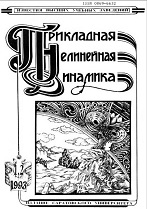|
This article is cited in 4 scientific papers (total in 4 papers)
APPLIED PROBLEMS OF NONLINEAR OSCILLATION AND WAVE THEORY
Optimization of Granger causation method parameters for the study of limbic epilepsy
M. V. Sysoevaa, T.M. Medvedevaab
a Saratov State University
b Institute for Higher Nervous Activity and Neurophysiology RAS, Moscow
Abstract:
Purpose. The aim is to reveal the dependence of Granger causality results on chosen time scales of constructed empirical models in application to the task of investigation of evolution of coupling between brain areas during limbic seizures.
Methods. We use combination of methods for coupling analysis of the experimental time series and approaches to modeling from the first principles, which reproduce the main time and frequency properties of the experimental signals. Such a combination use is novel for investigation of the connectivity between the brain areas from intracranial electroencephalogram. In this paper, it is used for connectivity analysis in limbic epilepsy provoked in WAG/Rij rats by the introduction of endocannabinoid receptor agonist.
Results. In ensembles of four coupled van der Pol oscillators with the Toda potential and hard excitation, Hindmarsh–Rose systems and FitzHugh–Nagumo systems we found regimes reproducing spectral and amplitude characteristics of the series of local potentials at the limbic seizures. Optimal method parameters were selected to target both sensitivity and specificity of Granger causality. Using these parameters, a significant increase in coupling was detected in the experimental data of WAG/Rij rats from the occipital cortex to the hippocampus during limbic seizures approximately 2 s before the seizure onset. The coupling return to background level immediately after the seizure termination.
Discussion. Reliability of coupling detection procedure outcomes is a key problem in applying the Granger causality method to experimental data. Increasing the method sensitivity and method specificity is possible in various ways, including increasing experimental data amount and adapting method parameters to the signal spectral properties, but none of these approaches solves the problem completely. In our opinion, the proposed approach, based on the construction of oscillator ensembles generating signals qualitatively similar to experimental ones, allows us to make significant progress in this direction.
Keywords:
time series, predictive models reconstruction, nonstationary signals, connectivity analysis, Granger causality, electroencephalogram, limbic epilepsy.
Received: 29.03.2018
Citation:
M. V. Sysoeva, T.M. Medvedeva, “Optimization of Granger causation method parameters for the study of limbic epilepsy”, Izvestiya VUZ. Applied Nonlinear Dynamics, 26:5 (2018), 39–62
Linking options:
https://www.mathnet.ru/eng/ivp95 https://www.mathnet.ru/eng/ivp/v26/i5/p39
|

|




 Contact us:
Contact us: Terms of Use
Terms of Use
 Registration to the website
Registration to the website Logotypes
Logotypes








 Citation in format
Citation in format 
